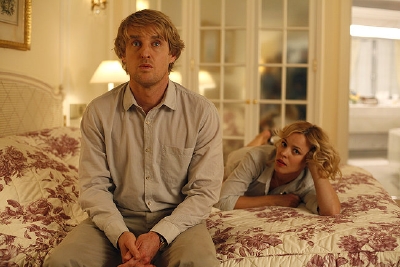Midnight in Paris: Hemingway’s Champagne Cocktail Recipe 🥁🥁🥁🥁
/Year Released: 2011
Directed by: Woody Allen
Starring: Owen Wilson, Rachel McAdams, Marion Cotilard, Kathy Bates
(PG-13, 94 min.)

"Life is full of misery, loneliness, and suffering - and it's all over much too soon." Woody Allen
Woody Allen’s 2011 tale is a love story of sorts, but the real object of his affection is not a girl but an entire city. Cobbled streets compel a stroll, sidewalk cafes invite a conversation, and lighted fountains are the song of sirens, luring us into their watery depths. Is it any wonder there is even more magic after midnight?
For Gil Pender (Owen Wilson), aspiring novelist and well-paid Hollywood hack, the city is a dream that will inspire his literary greatness just as it did his idols who lived and wrote there in between the last century’s great wars. To think that Ernest Hemmingway may have walked these very streets or that F. Scott Fitzgerald may have watched the Seine from this same café fills him with awe. He even contemplates abandoning the Malibu estate he and fiancée Inez (Rachel McAdams) call home for an attic apartment in Paris.
Inez not so much. In fact, the artistic beauty of the city is mostly lost on her except when she is fawning on every word her pedantic American professor friend utters as he gives impromptu tours of the museums and wineries. Almost everything about Gil she disparages. In fact, Inez has packed as much shrew in her pre nuptial bags as most matrons twice her age. But of course, she has a perfect role model in the form of her sharp-tongued mother Helen (Mimi Kennedy), who works overtime to embody every negative mother-in-law stereotype ever invented. When Gil balks at purchasing a matching pair of antique chairs she finds -- a bargain at 1,800 Euros apiece, she snaps, “Cheap is cheap.”
More than one critic has noticed Wood Allen’s “open contempt” for these characters. In fact, Inez and her American cohorts are so devoid of grace, one wonders how the mellow Gil has even made it this long through the engagement. Here Director Allen loses the light touch that usually serves him so well; he is every bit as heavy-handed and superficial in his American caricatures as he accuses them of being in real life.
Before we are too bogged down in this acrid portrayal, however, a little magic intervenes. In a kind of reversal of Cinderella, where the twelfth stroke of midnight turns her chariot into a pumpkin, the horses turning back into mice, Gil sees a kind of magic carriage arrive at that same timely hour. Well, It‘s not exactly a carriage but a 1920s Peugeot, loaded down with a raucous party of merrymakers. They invite him aboard, and he soon finds himself at a glorious party, where comments about bathtub gin and an abundance of bobbed hair and flapper dresses shock Gil into realizing that the fellow tinkling the ivories with a delightful rendition of “Let’s Do It,” is none other than Cole Porter himself.
It is a credit to Owen Wilson, who plays the Woody Allen surrogate here with a dreamer’s surreal vision, that he tumbles into this rabbit hole with such ease. Before he knows it, Gil is sharing shots with Hemingway (Corey Stoll), sitting down to conversations with Salvador Dali (Adrien Brody), and listening to Gertrude Stein (Kathy Bates) critique Picasso’s latest portrait of his mistress, the lovely Adriana (Marion Cotillard).
Here is where we start to have some fun, even if some of it is a little too closely tied to an insider’s knowledge of art of literature. Some of the best stuff involves Hemingway, probably the most readily known of the parade of writers and artists who parade past us. Hemingway’s lines read like one of the contests for the best parody of his work. He talks as though he is reading a passage out of The Old Man and the Sea and his pickup lines have a decidedly macho flavor: “Have you ever shot a charging lion?”
Picasso’s cubist painting – I’m sorry I’m not really a fan and I think his famous steel piece of “art” that adorns Chicago’s Daley Plaza is almost an atrocity -- is supposed to be a portrait of Adriana, but it more closely resembles my grandchildren’s crayon drawings that decorate my refrigerator. And when Kathy Bates as Gertrude Stein blathers on about it capturing the sensuous allure and sexual intensity of it subject, I have the sneaking suspicion that Woody Allen might share my taste in art.
Adrien Brody is almost as full of himself as the legendary Salvador Dali, having a great time telling Gil how he’d paint him as a rhinoceros with a great tear coming from his eye – in it the face of Christ or something equally as absurd, unless, of course, you have spent much time studying Dali’s actual work. Which is perhaps why he doesn’t bat an eye when Gil tells him he comes from the future. He is, after all, a surrealist.
While the daytime present day Paris borders on shrill, after midnight Woody Allen is at his best. Dancing above it all, he treats the Lost Generation with equal parts admiration and disdain, nudging their pretensions gently, like a pastry chef coaxing his dough. Kneading or needling, the touch is ever light and gentle.
— Kathy Borich

Film-Loving Foodie
"We ate well and cheaply and drank well and cheaply and slept well and warm together and loved each other," Hemingway reminisces about Paris in his Moveable Feast.
What better way to get into the spirit of Woody Allen’s Midnight in Paris than to join this great icon of the Lost Generation, Ernest Hemingway, for a delightful French Champagne Cocktail.
What makes it authentic is the Pernod, a French liqueur with many herbs, primarily star anise, which mimics the once popular Absinthe, once banned because of the wormwood in it.
If you are interested in the skinny behind absinthe and its dark reputation, read on.
“After the first glass, you see things as you wish they were. After the second, you see things as they are not. Finally, you see things as they really are, which is the most horrible thing in the world.”
This is what Oscar Wilde wrote of absinthe, the high-proof spirit tasting of anise, fennel and exotic aromatics.
Absinthe upholds quite the evocative reputation - it was banned in the early 1900s in most of Europe and the United States after drinkers often experienced visits from la fée verte, or the green fairy. Other legends took it further, claiming imbibers could succumb to insanity, suicide or even murder.
Hemingway’s Champagne Cocktail
Feeling literary? This is the perfect cocktail for you to sip.
1/2 flute Pernod
1/2 flute Champagne
Simply fill your flute halfway with Pernod, and then top off with the Champagne. Sit back with some soft music, and enjoy!
Pernod is a classic French liqueur with many herbs in it - primarily star anise. While this ends up with a licorice flavor, it doesn't actually have licorice.
Pernod is associated with absinthe, since back in 1797 it was Henri Pernod who brought absinthe into France. Absinthe is made up of absinthin - bitter, chlorophyll - the green stuff in leaves, and wormwood, which is the part that most people worry about. It is the wormwood that got absinthe banned.
Recipe Source: Weddings and Courtships.com
















